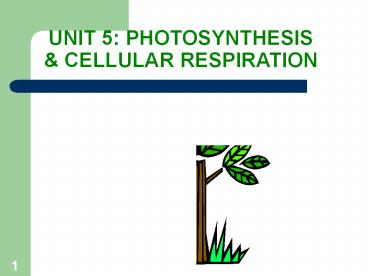UNIT%205:%20PHOTOSYNTHESIS - PowerPoint PPT Presentation
Title:
UNIT%205:%20PHOTOSYNTHESIS
Description:
UNIT 5: PHOTOSYNTHESIS & CELLULAR RESPIRATION * ENERGY AND LIFE Living things depend on energy Sun is source of most energy 2 types of organisms, AUTOTROPHS make ... – PowerPoint PPT presentation
Number of Views:71
Avg rating:3.0/5.0
Title: UNIT%205:%20PHOTOSYNTHESIS
1
UNIT 5 PHOTOSYNTHESIS CELLULAR RESPIRATION
2
ENERGY AND LIFE
- Living things depend on energy
- Sun is source of most energy
- 2 types of organisms,
- AUTOTROPHS make their own food (Ex plants,
bacteria, protists) - HETEROTROPHS get energy from the foods they
consume (animals, fungi)
3
KEY CONCEPT PHOTOSYNTHESISThe overall process
of photosynthesis produces sugars that store
chemical energy.
4
Photosynthetic organisms are producers.
- Plants use photosynthesis and are
producers/(autotrophs.) - Photosynthesis captures energy from sunlight to
make sugars.
5
Research On Photosynthesis
- VAN HELMONT- determined in the 1600s that plants
grew because of water. - PRIESTLEY- found that plants release oxygen.
- JAN INGENHOUSZ- found aquatic plants produce
oxygen bubbles in the light, therefore plants
need sunlight to produce oxygen
6
AN OVERVIEW OF PHOTOSYNTHESIS
- Plants use the energy of sunlight to
- convert water carbon dioxide into high energy
carbohydrates (sugar) - oxygen is a waste product.
- light
- 6H2O 6CO2 ? C6H12O6 6O2
- Reactants Products
7
What Else Does The Photosynthesizer Need?
- Chlorophyll- a chemical pigment that traps the
energy of the sun and converts it to chemical
energy
8
Capturing Light Energy
- White light ROY G BIV
- Chlorophyll captures (absorbs) energy at the ends
of the spectrum (red/orange blue/violet) - What you see is the wavelengths that are
reflected. (green)
9
Where Photosynthesis Occurs
- In the chloroplast
10
Where Photosynthesis Occurs
- Chlorophyll is a molecule that absorbs light
energy.
- In plants, chlorophyll is found in
organelles called chloroplasts.
11
- Photosynthesis is Many Reactions
- The equation for the overall process is
- 6CO2 6H2O ?????? C6H12O6 6O2
12
FACTORS THAT AFFECT PHOTOSYNTHESIS
- Amount of Water
- Amount of CO2
- Temperature
- Intensity of Light
- Wavelength of light
13
Cellular Respiration
KEY CONCEPT The overall process of cellular
respiration converts sugar into ATP (energy)
using oxygen.
14
CHEMICAL ENERGY AND ATP
- All living things use chemical energy
- A chemical compound that cells use to store and
release energy is ATP (ADENOSINE TRIPHOSPHATE). - ATP is like a fully charged battery ready to
power the machinery of a cell. - ATP powers many cellular activities Ex
- active transport across cell membranes,
- protein synthesis
- muscle contraction.
15
Cellular Respiration
- Cellular respiration makes ATP (energy) by
breaking down sugars. - Cellular respiration is aerobic, or requires
oxygen. - Cell respiration takes place in mitochondria.
16
Cellular Respiration
- The electron transport chain produces a large
amount of ATP (energy.)
- oxygen enters process
- PRODUCT
- ATP
- WASTE PRODUCTS
- Water
- Carbon dioxide
17
Cellular Respiration
- The equation for the overall process is
- C6H12O6 6O2 ?????? 6CO2 6H2O
- The reactants in photosynthesis are the same as
the products of cellular respiration.
18
ATP synthase (dont copy)
- Is an enzyme (-ase ending is a hint)
- Is a membrane protein.
- It is a protein pump that allows H ions to pass
thru the cell membrane - This is necessary for the formation of ATP
19
Quick Review of Organic Molecules in Living Things
- Carbohydrates (sugars, starches, etc.)
- Proteins
- Lipids (mainly fats)
- Nucleic acids (ATP, NADP, RNA, DNA)
20
Cellular Respiration
- Cells do not burn glucose, instead they slowly
release energy from glucose - They do this in many small steps-
- WHY?
If all the energy was released once, it would be
too much for the cell and it would be destroyed!
21
ANAEROBIC RESPIRATION
- When O2 is not present, a process called
FERMENTATION takes place. - FERMENTATION releases a small amount of ATP
(energy) from sugar.
22
2 Types of Fermentation
- ALCOHOLIC FERMENTATION
- produces carbon dioxide and alcohol.
- This type of fermentation causes bread dough to
rise. - .
23
2 Types of Fermentation, cont.
- 2. LACTIC ACID FERMENTATION
- is produced in your muscles during rapid exercise
when the body cant get enough oxygen to the
tissues. - With rapid exercise your muscles run out of
oxygen. Your muscle cells rapidly begin to
produce ATP by LACTIC ACID FERMENTATION
24
Fermentation
- Also occurs in the CYTOPLASM































